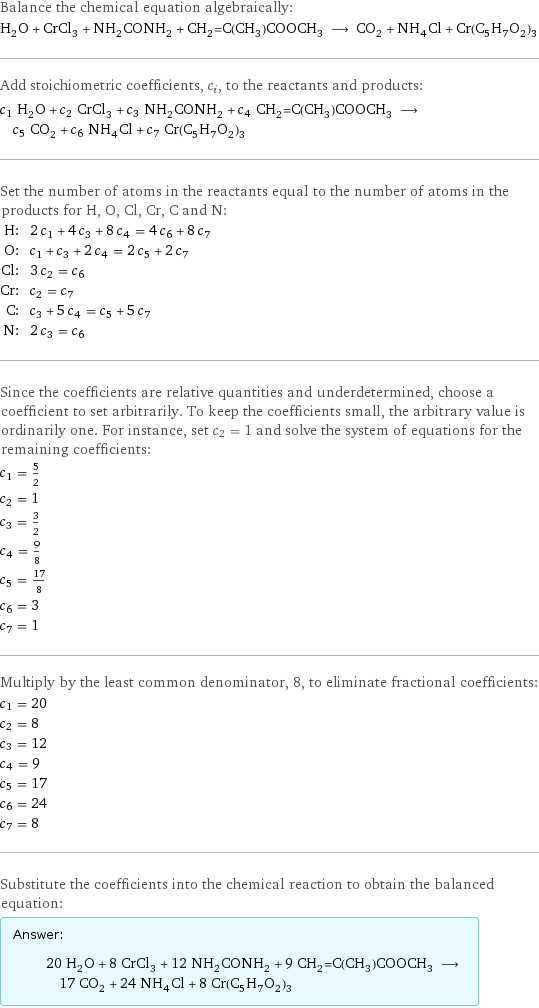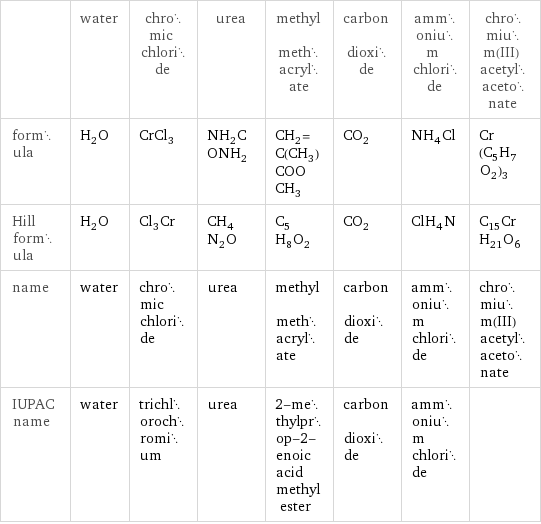Input interpretation

H_2O water + CrCl_3 chromic chloride + NH_2CONH_2 urea + CH_2=C(CH_3)COOCH_3 methyl methacrylate ⟶ CO_2 carbon dioxide + NH_4Cl ammonium chloride + Cr(C_5H_7O_2)_3 chromium(III) acetylacetonate
Balanced equation

Balance the chemical equation algebraically: H_2O + CrCl_3 + NH_2CONH_2 + CH_2=C(CH_3)COOCH_3 ⟶ CO_2 + NH_4Cl + Cr(C_5H_7O_2)_3 Add stoichiometric coefficients, c_i, to the reactants and products: c_1 H_2O + c_2 CrCl_3 + c_3 NH_2CONH_2 + c_4 CH_2=C(CH_3)COOCH_3 ⟶ c_5 CO_2 + c_6 NH_4Cl + c_7 Cr(C_5H_7O_2)_3 Set the number of atoms in the reactants equal to the number of atoms in the products for H, O, Cl, Cr, C and N: H: | 2 c_1 + 4 c_3 + 8 c_4 = 4 c_6 + 8 c_7 O: | c_1 + c_3 + 2 c_4 = 2 c_5 + 2 c_7 Cl: | 3 c_2 = c_6 Cr: | c_2 = c_7 C: | c_3 + 5 c_4 = c_5 + 5 c_7 N: | 2 c_3 = c_6 Since the coefficients are relative quantities and underdetermined, choose a coefficient to set arbitrarily. To keep the coefficients small, the arbitrary value is ordinarily one. For instance, set c_2 = 1 and solve the system of equations for the remaining coefficients: c_1 = 5/2 c_2 = 1 c_3 = 3/2 c_4 = 9/8 c_5 = 17/8 c_6 = 3 c_7 = 1 Multiply by the least common denominator, 8, to eliminate fractional coefficients: c_1 = 20 c_2 = 8 c_3 = 12 c_4 = 9 c_5 = 17 c_6 = 24 c_7 = 8 Substitute the coefficients into the chemical reaction to obtain the balanced equation: Answer: | | 20 H_2O + 8 CrCl_3 + 12 NH_2CONH_2 + 9 CH_2=C(CH_3)COOCH_3 ⟶ 17 CO_2 + 24 NH_4Cl + 8 Cr(C_5H_7O_2)_3
Structures

+ + + ⟶ + +
Names

water + chromic chloride + urea + methyl methacrylate ⟶ carbon dioxide + ammonium chloride + chromium(III) acetylacetonate
Equilibrium constant
![Construct the equilibrium constant, K, expression for: H_2O + CrCl_3 + NH_2CONH_2 + CH_2=C(CH_3)COOCH_3 ⟶ CO_2 + NH_4Cl + Cr(C_5H_7O_2)_3 Plan: • Balance the chemical equation. • Determine the stoichiometric numbers. • Assemble the activity expression for each chemical species. • Use the activity expressions to build the equilibrium constant expression. Write the balanced chemical equation: 20 H_2O + 8 CrCl_3 + 12 NH_2CONH_2 + 9 CH_2=C(CH_3)COOCH_3 ⟶ 17 CO_2 + 24 NH_4Cl + 8 Cr(C_5H_7O_2)_3 Assign stoichiometric numbers, ν_i, using the stoichiometric coefficients, c_i, from the balanced chemical equation in the following manner: ν_i = -c_i for reactants and ν_i = c_i for products: chemical species | c_i | ν_i H_2O | 20 | -20 CrCl_3 | 8 | -8 NH_2CONH_2 | 12 | -12 CH_2=C(CH_3)COOCH_3 | 9 | -9 CO_2 | 17 | 17 NH_4Cl | 24 | 24 Cr(C_5H_7O_2)_3 | 8 | 8 Assemble the activity expressions accounting for the state of matter and ν_i: chemical species | c_i | ν_i | activity expression H_2O | 20 | -20 | ([H2O])^(-20) CrCl_3 | 8 | -8 | ([CrCl3])^(-8) NH_2CONH_2 | 12 | -12 | ([NH2CONH2])^(-12) CH_2=C(CH_3)COOCH_3 | 9 | -9 | ([CH2=C(CH3)COOCH3])^(-9) CO_2 | 17 | 17 | ([CO2])^17 NH_4Cl | 24 | 24 | ([NH4Cl])^24 Cr(C_5H_7O_2)_3 | 8 | 8 | ([Cr(C5H7O2)3])^8 The equilibrium constant symbol in the concentration basis is: K_c Mulitply the activity expressions to arrive at the K_c expression: Answer: | | K_c = ([H2O])^(-20) ([CrCl3])^(-8) ([NH2CONH2])^(-12) ([CH2=C(CH3)COOCH3])^(-9) ([CO2])^17 ([NH4Cl])^24 ([Cr(C5H7O2)3])^8 = (([CO2])^17 ([NH4Cl])^24 ([Cr(C5H7O2)3])^8)/(([H2O])^20 ([CrCl3])^8 ([NH2CONH2])^12 ([CH2=C(CH3)COOCH3])^9)](../image_source/4a6af145f47532201fd625a83cde14e8.png)
Construct the equilibrium constant, K, expression for: H_2O + CrCl_3 + NH_2CONH_2 + CH_2=C(CH_3)COOCH_3 ⟶ CO_2 + NH_4Cl + Cr(C_5H_7O_2)_3 Plan: • Balance the chemical equation. • Determine the stoichiometric numbers. • Assemble the activity expression for each chemical species. • Use the activity expressions to build the equilibrium constant expression. Write the balanced chemical equation: 20 H_2O + 8 CrCl_3 + 12 NH_2CONH_2 + 9 CH_2=C(CH_3)COOCH_3 ⟶ 17 CO_2 + 24 NH_4Cl + 8 Cr(C_5H_7O_2)_3 Assign stoichiometric numbers, ν_i, using the stoichiometric coefficients, c_i, from the balanced chemical equation in the following manner: ν_i = -c_i for reactants and ν_i = c_i for products: chemical species | c_i | ν_i H_2O | 20 | -20 CrCl_3 | 8 | -8 NH_2CONH_2 | 12 | -12 CH_2=C(CH_3)COOCH_3 | 9 | -9 CO_2 | 17 | 17 NH_4Cl | 24 | 24 Cr(C_5H_7O_2)_3 | 8 | 8 Assemble the activity expressions accounting for the state of matter and ν_i: chemical species | c_i | ν_i | activity expression H_2O | 20 | -20 | ([H2O])^(-20) CrCl_3 | 8 | -8 | ([CrCl3])^(-8) NH_2CONH_2 | 12 | -12 | ([NH2CONH2])^(-12) CH_2=C(CH_3)COOCH_3 | 9 | -9 | ([CH2=C(CH3)COOCH3])^(-9) CO_2 | 17 | 17 | ([CO2])^17 NH_4Cl | 24 | 24 | ([NH4Cl])^24 Cr(C_5H_7O_2)_3 | 8 | 8 | ([Cr(C5H7O2)3])^8 The equilibrium constant symbol in the concentration basis is: K_c Mulitply the activity expressions to arrive at the K_c expression: Answer: | | K_c = ([H2O])^(-20) ([CrCl3])^(-8) ([NH2CONH2])^(-12) ([CH2=C(CH3)COOCH3])^(-9) ([CO2])^17 ([NH4Cl])^24 ([Cr(C5H7O2)3])^8 = (([CO2])^17 ([NH4Cl])^24 ([Cr(C5H7O2)3])^8)/(([H2O])^20 ([CrCl3])^8 ([NH2CONH2])^12 ([CH2=C(CH3)COOCH3])^9)
Rate of reaction
![Construct the rate of reaction expression for: H_2O + CrCl_3 + NH_2CONH_2 + CH_2=C(CH_3)COOCH_3 ⟶ CO_2 + NH_4Cl + Cr(C_5H_7O_2)_3 Plan: • Balance the chemical equation. • Determine the stoichiometric numbers. • Assemble the rate term for each chemical species. • Write the rate of reaction expression. Write the balanced chemical equation: 20 H_2O + 8 CrCl_3 + 12 NH_2CONH_2 + 9 CH_2=C(CH_3)COOCH_3 ⟶ 17 CO_2 + 24 NH_4Cl + 8 Cr(C_5H_7O_2)_3 Assign stoichiometric numbers, ν_i, using the stoichiometric coefficients, c_i, from the balanced chemical equation in the following manner: ν_i = -c_i for reactants and ν_i = c_i for products: chemical species | c_i | ν_i H_2O | 20 | -20 CrCl_3 | 8 | -8 NH_2CONH_2 | 12 | -12 CH_2=C(CH_3)COOCH_3 | 9 | -9 CO_2 | 17 | 17 NH_4Cl | 24 | 24 Cr(C_5H_7O_2)_3 | 8 | 8 The rate term for each chemical species, B_i, is 1/ν_i(Δ[B_i])/(Δt) where [B_i] is the amount concentration and t is time: chemical species | c_i | ν_i | rate term H_2O | 20 | -20 | -1/20 (Δ[H2O])/(Δt) CrCl_3 | 8 | -8 | -1/8 (Δ[CrCl3])/(Δt) NH_2CONH_2 | 12 | -12 | -1/12 (Δ[NH2CONH2])/(Δt) CH_2=C(CH_3)COOCH_3 | 9 | -9 | -1/9 (Δ[CH2=C(CH3)COOCH3])/(Δt) CO_2 | 17 | 17 | 1/17 (Δ[CO2])/(Δt) NH_4Cl | 24 | 24 | 1/24 (Δ[NH4Cl])/(Δt) Cr(C_5H_7O_2)_3 | 8 | 8 | 1/8 (Δ[Cr(C5H7O2)3])/(Δt) (for infinitesimal rate of change, replace Δ with d) Set the rate terms equal to each other to arrive at the rate expression: Answer: | | rate = -1/20 (Δ[H2O])/(Δt) = -1/8 (Δ[CrCl3])/(Δt) = -1/12 (Δ[NH2CONH2])/(Δt) = -1/9 (Δ[CH2=C(CH3)COOCH3])/(Δt) = 1/17 (Δ[CO2])/(Δt) = 1/24 (Δ[NH4Cl])/(Δt) = 1/8 (Δ[Cr(C5H7O2)3])/(Δt) (assuming constant volume and no accumulation of intermediates or side products)](../image_source/2bd331db627cfa61b339580491f0a11d.png)
Construct the rate of reaction expression for: H_2O + CrCl_3 + NH_2CONH_2 + CH_2=C(CH_3)COOCH_3 ⟶ CO_2 + NH_4Cl + Cr(C_5H_7O_2)_3 Plan: • Balance the chemical equation. • Determine the stoichiometric numbers. • Assemble the rate term for each chemical species. • Write the rate of reaction expression. Write the balanced chemical equation: 20 H_2O + 8 CrCl_3 + 12 NH_2CONH_2 + 9 CH_2=C(CH_3)COOCH_3 ⟶ 17 CO_2 + 24 NH_4Cl + 8 Cr(C_5H_7O_2)_3 Assign stoichiometric numbers, ν_i, using the stoichiometric coefficients, c_i, from the balanced chemical equation in the following manner: ν_i = -c_i for reactants and ν_i = c_i for products: chemical species | c_i | ν_i H_2O | 20 | -20 CrCl_3 | 8 | -8 NH_2CONH_2 | 12 | -12 CH_2=C(CH_3)COOCH_3 | 9 | -9 CO_2 | 17 | 17 NH_4Cl | 24 | 24 Cr(C_5H_7O_2)_3 | 8 | 8 The rate term for each chemical species, B_i, is 1/ν_i(Δ[B_i])/(Δt) where [B_i] is the amount concentration and t is time: chemical species | c_i | ν_i | rate term H_2O | 20 | -20 | -1/20 (Δ[H2O])/(Δt) CrCl_3 | 8 | -8 | -1/8 (Δ[CrCl3])/(Δt) NH_2CONH_2 | 12 | -12 | -1/12 (Δ[NH2CONH2])/(Δt) CH_2=C(CH_3)COOCH_3 | 9 | -9 | -1/9 (Δ[CH2=C(CH3)COOCH3])/(Δt) CO_2 | 17 | 17 | 1/17 (Δ[CO2])/(Δt) NH_4Cl | 24 | 24 | 1/24 (Δ[NH4Cl])/(Δt) Cr(C_5H_7O_2)_3 | 8 | 8 | 1/8 (Δ[Cr(C5H7O2)3])/(Δt) (for infinitesimal rate of change, replace Δ with d) Set the rate terms equal to each other to arrive at the rate expression: Answer: | | rate = -1/20 (Δ[H2O])/(Δt) = -1/8 (Δ[CrCl3])/(Δt) = -1/12 (Δ[NH2CONH2])/(Δt) = -1/9 (Δ[CH2=C(CH3)COOCH3])/(Δt) = 1/17 (Δ[CO2])/(Δt) = 1/24 (Δ[NH4Cl])/(Δt) = 1/8 (Δ[Cr(C5H7O2)3])/(Δt) (assuming constant volume and no accumulation of intermediates or side products)
Chemical names and formulas

| water | chromic chloride | urea | methyl methacrylate | carbon dioxide | ammonium chloride | chromium(III) acetylacetonate formula | H_2O | CrCl_3 | NH_2CONH_2 | CH_2=C(CH_3)COOCH_3 | CO_2 | NH_4Cl | Cr(C_5H_7O_2)_3 Hill formula | H_2O | Cl_3Cr | CH_4N_2O | C_5H_8O_2 | CO_2 | ClH_4N | C_15CrH_21O_6 name | water | chromic chloride | urea | methyl methacrylate | carbon dioxide | ammonium chloride | chromium(III) acetylacetonate IUPAC name | water | trichlorochromium | urea | 2-methylprop-2-enoic acid methyl ester | carbon dioxide | ammonium chloride |